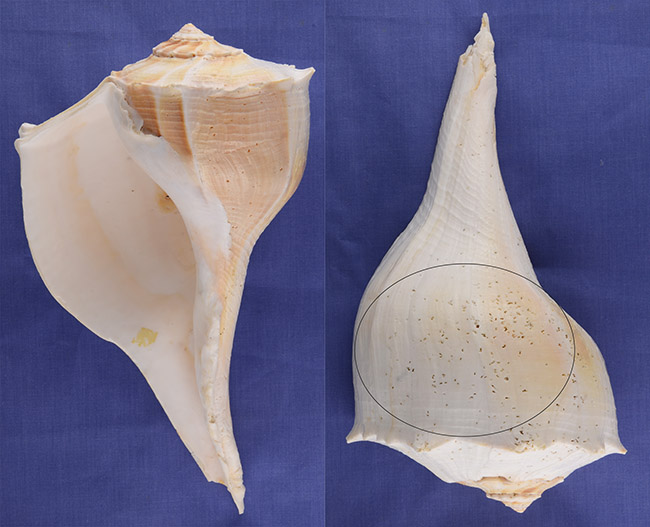
Mary Beth Trubitt (Arkansas Archeological Survey, Henderson State University Research Station)
Artifact of the Month - December 2019
While they are not commonly found on archeological sites in southwest Arkansas, a variety of marine shell ornaments—earspools, beads, pendants, and gorgets—were used by the ancestral Caddo Indians who lived here between about AD 1000 and 1700. This engraved shell ornament is a gorget, so named because it would have been worn at the throat suspended from a necklace. It has an irregular circular shape, and there are two drilled suspension holes at the top (Figure 1). It was cut from the body whorl of a large whelk shell, presumably lightning whelk, Busycon sinistrum (aka Sinistrofulgur sinistrum) originating from the Gulf Coast (Figure 2). The gorget was engraved on the interior surface with concentric circles and a central four-pointed cross. With an outer segmented band and an interior band filled with punctations, the design recalls the scalloped triskele or Nashville style of engraved shell gorgets more commonly seen in Mississippian contexts in eastern Tennessee (Brain and Phillips 1996; Sullivan 2007).

Artifact 1974-249 came from the Shepherd site (3CL39) in Clark County, Arkansas. At one time the site had one or two mounds, but was impacted by bulldozing in the mid-1960s, revealing Archaic and Caddo period artifacts. The shell gorget was collected from the site and donated to the Arkansas Archeological Survey’s HSU Research Station in 1974 by Dale Patrick. It was one of two marine shell gorgets from the station’s curated collections that I described in detail in a Caddo Archeology Journal article (Trubitt 2010). In 2018 and 2019, Dr. Patrick donated the remainder of his collection to the Survey’s HSU Research Station, along with notebooks describing his archeological activities from the 1960s when he was a university student. These notes indicate the gorget came from a grave that also contained two ceramic seed jars and a Friendship Engraved bowl, indicating deposition during the Mid-Ouachita phase (AD 1400–1500) of the Caddo period.
This gorget, now considered to be an unassociated funerary object in terms of the Native American Graves Protection and Repatriation Act (NAGPRA), gives us a glimpse into the kinds of ornaments used as identity markers and worn by ancestral Caddos living in the Middle Ouachita River valley in the fifteenth century. While the engraved design on the Shepherd gorget is unusual (Figure 3a), it resembles several other shell gorgets from Caddo sites. One from the Kirkham site, also in Clark County (Figure 3b), was described in an Arkansas Archeologist article by Meeks Etchieson (1981). A similar gorget with scalloped edge, two concentric bands with punctations, and a central curved-line element (Figure 3c), came from a grave at the Sam Kaufman site in Texas (Skinner et al. 1969). The Kirkham gorget has a four-armed tetraskelion at the center while the Sam Kaufman gorget has a three-armed triskele. A gorget described and illustrated by C. B. Moore (1912) from a burial at the Foster Place, on the Red River in southwest Arkansas, has scallops spaced around the outer edge, a band of engraved diamonds, and a cut-out tetraskelion in the center (Figure 3d). The gorgets from the Caddo area are similar but not identical to the triskele or Nashville style gorgets found in eastern Tennessee ca. AD 1350–1450 (such as the one from Hiwassee Island [Lewis and Kneberg 1970], Figure 3e), suggesting wider connections and interactions between the Caddo and Mississippian worlds (Girard et al. 2014).

Materials: marine shell
Dimensions: 11.2 x 11.7 cm
Age Estimate: AD 1400–1500 (Caddo period, Mid-Ouachita phase)
Curation: Arkansas Archeological Survey, Henderson State University Research Station, Arkadelphia.
Thank you to Chairman Francis of the Caddo Nation of Oklahoma.
* * *
References for Further Reading:
Brain, Jeffrey P., and Philip Phillips, with the assistance of Susan P. Sheldon
1996 Shell Gorgets: Styles of the Late Prehistoric and Protohistoric Southeast. Peabody Museum of Archaeology and Ethnology, Harvard University, Peabody Museum Press, Cambridge.
Etchieson, G. Meeks
1981 A Shell Gorget from the Kirkham Site. The Arkansas Archeologist 22:1–3.
Girard, Jeffrey S., Timothy K. Perttula, and Mary Beth Trubitt
2014 Caddo Connections: Cultural Interactions within and beyond the Caddo World. Rowman and Littlefield, Lanham, Maryland.
Lewis, Thomas M. N., and Madeline Kneberg
1970 Hiwassee Island: An Archaeological Account of Four Tennessee Indian Peoples. University of Tennessee Press, Knoxville.
Moore, Clarence B.
1912 Some Aboriginal Sites on Red River. Journal of the Academy of Natural Sciences of Philadelphia, Second Series, XIV:483–638.
Skinner, S. Alan, R. King Harris, and Keith M. Anderson (editors)
1969 Archaeological Investigations at the Sam Kaufman Site, Red River County, Texas. Contributions in Anthropology No. 5, Department of Anthropology, Southern Methodist University, Dallas.
Sullivan, Lynne P.
2007 Shell Gorgets, Time, and the Southeastern Ceremonial Complex in Southeastern Tennessee. In Southeastern Ceremonial Complex: Chronology, Content, Context, edited by Adam King, pp. 88–106. University of Alabama Press, Tuscaloosa.
Trubitt, Mary Beth
2010 Two Shell Gorgets from Southwest Arkansas. Caddo Archeology Journal 20:129–137.
 Collections and items in our institution have incomplete, inaccurate, and/or missing attribution. We are using this notice to clearly identify this material so that it can be updated, or corrected by communities of origin. Our institution is committed to collaboration and partnerships to address this problem of incorrect or missing attribution. For more information, visit localcontexts.org.
Collections and items in our institution have incomplete, inaccurate, and/or missing attribution. We are using this notice to clearly identify this material so that it can be updated, or corrected by communities of origin. Our institution is committed to collaboration and partnerships to address this problem of incorrect or missing attribution. For more information, visit localcontexts.org.
 The Arkansas Archeological Survey is committed to the development of new modes of collaboration, engagement, and partnership with Indigenous peoples for the care and stewardship of past and future heritage collections.
The Arkansas Archeological Survey is committed to the development of new modes of collaboration, engagement, and partnership with Indigenous peoples for the care and stewardship of past and future heritage collections.
 The TK Notice is a visible notification that there are accompanying cultural rights and responsibilities that need further attention for any future sharing and use of this material. The TK Notice may indicate that TK Labels are in development and their implementation is being negotiated. For more information about the TK Notice, visit localcontexts.org.
The TK Notice is a visible notification that there are accompanying cultural rights and responsibilities that need further attention for any future sharing and use of this material. The TK Notice may indicate that TK Labels are in development and their implementation is being negotiated. For more information about the TK Notice, visit localcontexts.org.
